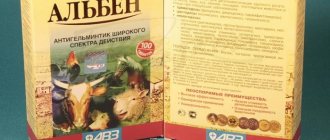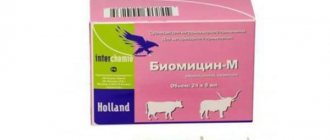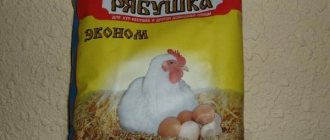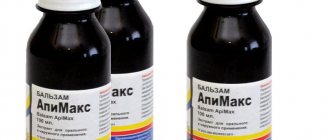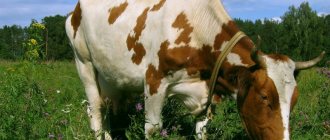How to use, dosage
According to the instructions for the drug, Timpanol is administered orally, injections are not given. In this case, a food probe or the tip of a rubber bottle is inserted into the animal's rumen cavity.
The dosage of the medicine is calculated depending on the total weight of the livestock.
Before use, the product must be shaken first, since sediment may form during storage, and then mixed with water in a ratio of 1:10 or 1:15.
For goats
For this group of animals, the dosage is 0.5-1 milliliters per kilogram of weight.
For rabbits
Rabbits and other fur-bearing animals are given the drug depending on their weight:
- for animals weighing up to 400 g, dilute 0.2 ml of the medicine in 0.8 ml of water and give it 5 times a day;
- For animals over 400 g, 0.4 ml is diluted in 1.6 ml of water and also given 5 times a day.
Be sure to read:
Treatment of respiratory diseases in birds with iodine bomb Dixam and Kliodesiv, instructions for use
For cows
For cows, the solution is prepared based on a dosage of 0.4-0.5 milliliters per kilogram of weight.
Can Timpanol be given to other animals?
It is not recommended to treat other animals with Timpanol, since it is intended specifically for ruminants, which have a specific stomach structure.
Pets such as cats and dogs have their own digestive habits, and bloating can be caused by other reasons.
Dosage and recommendations for use
According to the instructions for use, the veterinary drug is given to ruminants and cattle orally, injected directly into the stomach cavity. To do this, use an esophageal probe or take a rubber bottle. An injection needle or trocar may be used. This instrument is used to pierce the skin in the area of the left hungry fossa. Mares and stallions are administered Timpanol as an injection into the head of the cecum or orally through a nasopharyngeal tube.
Advice. Injecting the solution through a puncture directly into the rumen or intestines is practiced by veterinarians in severe cases. In other situations, it is better to give the remedy by mouth.
Recommended norms for different types of animals in relation to their body weight:
- cows - 0.4-0.5 ml/kg;
- horses - 0.4-0.5 ml/kg;
- ruminants - 0.5-1.0 ml/kg.
The dosage is indicated taking into account the fact that the medicine has already been diluted in water. A solution is prepared from Timpanol in a concentration of 1:10 or 1:15. Before adding it, shake it until smooth. The drug is used once, there is no course therapy. If symptoms are not eliminated within a quarter of an hour from the moment Timpanol enters the gastrointestinal tract, repeat the administration - this time at a concentration of 1:5 or 1:10.
Signs of overdose when exceeding the norm in animals have not been found in practice. However, the instructions for use mention a decrease in the therapeutic effect in this case. Timpanol is a fairly strong remedy that helps with certain dysfunctions of the gastrointestinal tract. It is advisable for all livestock farmers to have the medicine in their first aid kit.
What remedies do you use to combat the problem of bloating in pets?
What is tympany, symptoms
Tympania is a disease characteristic of ruminants , in which gases accumulate in the rumen, which can lead to the death of the animal.
Timpanol is considered one of the most necessary products in the first aid kit of rabbit breeders.
It is most often observed in livestock over 6 years of age, as well as when using low-quality feed, for example, rotten root crops.
As a result, the animal cannot regurgitate the cud and digest it in the next section, the contents of the rumen begin to ferment, swell, and compression of the intestines and some other organs occurs.
Symptoms of the disease are:
- enlargement in the left side of the abdominal cavity due to swelling of the scar;
- the animal's anxiety: it waves its tail, wags, looks back at its stomach, and so on;
- a change in breathing, which becomes difficult, superficial, while the chest tenses, the animal tries to stretch its neck.
Instructions, methods of use
Before use, the drug is diluted with water in a ratio of 1:10-1:15, after shaking until a homogeneous mass (emulsion) is obtained.
To sick ruminant animals (including cows, calves), the drug is administered orally using a rubber bottle or esophageal tube directly into the rumen cavity. It can be inserted into the scar cavity and through the abdominal wall in the area of the left hungry fossa using a trocar.
Tympanol is administered to horses using a nasopharyngeal probe or a syringe through the abdominal wall in the area of the head of the cecum. Doses in ml of diluted drug per 1 kg of animal weight: for cattle and horses - 0.4-0.5 ml/kg; goats and sheep - 0.5-1 ml/kg.
If the symptoms of the disease do not disappear within 15-20 minutes after the administration of tympanol, the drug is administered to the animal again in the indicated doses in a dilution of 1:5-1:10.
The use of tympanol for cattle does not exclude the use of other drugs.
For goats
For this group of animals, the dosage is 0.5-1 milliliters per kilogram of weight.
For rabbits
Rabbits and other fur-bearing animals are given the drug depending on their weight:
- for animals weighing up to 400 g, dilute 0.2 ml of the medicine in 0.8 ml of water and give it 5 times a day;
- For animals over 400 g, 0.4 ml is diluted in 1.6 ml of water and also given 5 times a day.
For cows
For cows, the solution is prepared based on a dosage of 0.4-0.5 milliliters per kilogram of weight.
Can Timpanol be given to other animals?
It is not recommended to treat other animals with Timpanol, since it is intended specifically for ruminants, which have a specific stomach structure.
Pets such as cats and dogs have their own digestive habits, and bloating can be caused by other reasons.
Composition and action Timpanol
The drug is available in the form of a yellow-green emulsion with a characteristic odor. It is packaged in bottles made of polymers or medical glass with screw caps.
The basis of the product is extracts of the herbaceous part of wormwood and the rhizomes of Lobel's cheremitsa.
Be sure to read:
Broad spectrum antibiotics for chickens, why give them to chickens and chickens: Oflosan, Baytril, Enroflon, Biovit-80
The following are present as excipients in Timpanol:
- polyvinyl alcohol;
- lactic acid;
- organosilicon defoamer;
- distilled or drinking water;
- aerosil.
Timpanol has a positive effect on the digestive system of animals due to:
- reduction of gas formation;
- increasing the production of juices and peristalsis of the digestive tract;
- breaking up already formed gas bubbles;
- reducing the activity of the sphincters of the mesh, book and rumen, which allows you to increase the speed of movement of food mass through the digestive tract;
- destroying pathogenic bacteria and inducing vomiting.
Composition and release form of the veterinary drug
"Timpanol" (Timpanolum) is the international name for an emulsion made from medicinal plants. The medicine contains hellebore lobel extract, wormwood and lactic acid. Additional substances in Timpanol include aerosil, distilled water, polyvinyl alcohol and silicone defoamer.
The drug is prepared in the form of a homogeneous mass of greenish-yellow color. It has an unpleasant, specific smell. The medicine refers to drugs for the treatment of diseases of the gastrointestinal tract of animals.
"Timpanol" is available in glass and plastic bottles, packaged in 200 ml. The natural remedy does not pose a threat to the lives of people and animals. According to official data, the drug belongs to hazard class 4 (Source - GOST 12.1. 007-76).
Main properties of "Timpanol":
- Suppresses fermentation and gas formation. Improves microflora in the intestines.
- Strengthens the production of gastric juice.
- Destroys pathogenic microorganisms.
- Causes vomiting. Restores the frequency of rumen contractions.
- Grinds up pieces of undigested food and removes it from the body.
- Strengthens peristalsis.
- Has a foam-suppressing effect.
- Relaxes the sphincters of the stomach. This speeds up the movement of food in the intestines.
- Destroys the smallest gas bubbles contained in succulent feed.
Pharmacological properties
Bloating in a cow
The instructions for use of Timpanol also describe its pharmacological properties, namely:
- antifermentative;
- ruminatory;
- foam suppressant;
- inhibiting fermentation microflora;
- improves peristalsis and gastric motility;
- destroying lumps of undigested food and moving it further into the intestines;
- accelerating the processes of evacuation of feed masses.
Special instructions, storage, price
The medicine should be stored in its original packaging, which provides maximum protection against spoilage of the substance.
Storage conditions:
- temperature from 0 to +20 degrees;
- dry place;
- lack of direct sunlight;
- maintenance for up to 18 months;
- storage separately from animal feed.
After the end of the warranty period, the drug cannot be used. If any amount of substance remains, it must be disposed of.
It is advisable to use gloves while working with Timpanol, and wash your hands after completion.
If the drug gets on the skin, it should be washed off with plenty of water. The cost of a medicine with a volume of 200 milliliters is about 50 rubles.
Indications and prohibition on the use of the drug
Veterinarians prescribe Timpanol for the treatment of:
- tympanitis in cows, other cattle, goats and sheep (acute gastric bloating);
- accumulation of digestive gases in the intestines of horses.
There are no side effects or complications from taking Timpanol if the owner follows the dosage standards. Contraindications indicated in the instructions for use:
- allergic reaction;
- increased sensitivity.
The medicine is non-toxic for animals and humans and belongs to the category of low-hazard substances. Dairy and meat products can be used for food without restrictions. Timpanol is allowed to be combined with other medications as a primary or adjuvant agent. When closed and after opening, it is stored for 18 months. from the date of production. Store Timpanol in its original packaging, separate from feed and food, in a dry place out of direct sunlight. Recommended temperature is from 0 to +20 °C.
Attention! The drug cannot be used after the expiration date.
What other analogues exist?
A complete analogue of the drug on the domestic market is Atimpanol, the peculiarity of which is a slightly different proportion of active ingredients and the addition of vegetable oil.
The drug can be partially replaced by:
- Cheremitsa tincture;
- tincture of wormwood;
- lactic acid.
These components are part of the medicine, but individually their effectiveness will be significantly lower. Folk remedies are also used in the form of decoctions and tinctures, but their preparation takes time.
Be sure to read:
Chiktonik and Gammatonic: instructions for use for birds, indications, dosage, principle of operation
